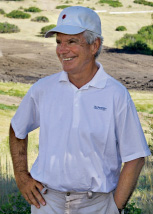Architects by design
Three turf pros switched from course maintenance to course design — and found success.
– By Anthony Pioppi
It was as head greenkeeper of the Old Course in St. Andrews, Scotland that Old Tom Morris was called on to modify the design. His work was so admired that it led to a career in golf course architecture.
Donald Ross was born in Dornoch, Scotland, and worked for Old Tom Morris. He made his mark as a head greenkeeper, head golf professional and an accomplished player before establishing himself as an architect in the early 1900s at Boston’s Oakley Country Club.
Now, though, there are few practitioners of course design who came to the architecture world from golf course maintenance. Three who did say understanding the needs and expectations of a golf course superintendent is good and bad. Yes, it helps them understand the wants of those who take care of turf, but ease of maintenance cannot be the overriding factor when laying out or renovating a course.
Bill Coore was a superintendent in Texas before moving to architecture; Brian Silva earned two agronomic degrees, taught turf at two schools and was a USGA Green Section agronomist before he became an architect; and Kris Spence was a head superintendent at a number of courses, one of which he redesigned, before he decided to switch professions.
Common ground
Even though all three of them started in the grass-growing sector of golf, each had an affinity for design and Classic Era architecture.
Coore and Crenshaw, through their own designs, are significant in architecture’s retro movement, which saw the re-implementation of strategy. Silva embraced the same ideals and established a name for himself with his own heralded work. He renovated and restored, to much acclaim, a number of marquee layouts designed by Seth Raynor and Ross. Spence, who has made a career of returning Classic Era layouts back to their original form, thrust himself into the architecture discussion with his restoration of Greensboro Country Club’s Donald Ross 18.
Valuable experience
Coore’s experience working as a superintendent helped him grasp the dynamics of course maintenance.
Spence, for his part, strives to create a situation where three distinct groups have equal input on design decisions.
“I’ve always felt the golf course architect, the golf course superintendent and the members need to have a good balance,” he said.
He cites as an example one layout he renovated in which the green surfaces had shrunk significantly. Old aerial photographs showed that in the early days the green top was spilling over the side of the fill pad. Members wanted the green to be as it once was, but the superintendent desired a ring of rough, then collar, around green.
Spence had to find a compromise. He explained to the membership that because of modern equipment and mowing heights, the putting surface would need a collar around it. Then he showed the superintendent how his course restoration approach would actually eliminate the intent of the original architect.
Ultimately, Spence convinced them all that an 18-inch collar was the solution. “Because I was a superintendent, they will accept my reasoning,” he said.
Coore’s road to course design
Coore’s circuitous route to architecture began, in a way, in ancient Greece. In 1968 he graduated from Wake Forest University with a degree in Classical Greek. His goal was to obtain a master’s degree and become a professor. At the time, his only connection to golf was that of an avid player. But all that changed when Coore saw Pete Dye’s Oak Hollow Golf Course while it was under construction.
Coore badgered Dye for a job until he was hired as a laborer on the construction team. Afterward, Coore continued working for Pete Dye and his brother Roy. It was on Roy’s layout, Waterwood National in Texas, that Coore learned the business of turf maintenance.
“They needed a superintendent, and quite frankly, I think they couldn’t find anyone else to take the job,” he laughed.
Coore was encouraged to take the job by people who worked for the Dye company. So he took it. And he learned the trade in two-week increments from a soil consultant. “I went to the school of Dick Psolla,” Coore recounted.
Psolla has been a consultant for Brookside Laboratories since 1960. “I had a work ethic but no technical knowledge,” Coore said. But after six years at Waterwood, he was given the chance to design his first course, Rockport Country Club.
During the two years of construction, he remained as Waterwood superintendent, then went out on his own for a few years before teaming with Crenshaw. Their first two courses, Barton Creek Resort and Spa in Texas and Kapalua Resort in Hawaii, opened in 1991.
A chance encounter
Silva’s path was more traditional.
When growing up in Massachusetts, Silva’s father, a heavy equipment operator, took on some golf course shaping work for a local contractor. For the next 15 years the majority of his business involved working with architects such as Geoffrey Cornish, George Fazio and Phil Wogan.
“I wanted to run equipment and build golf courses. I went to work with my father, and he gave me a wheelbarrow with a rake in it,” Silva said. “That cured my desire to build golf courses.”
While on one of his father’s jobs a few years later, Silva met Cornish and asked him for advice on becoming an architect. Cornish told him to get turf and landscape architecture degrees and work summers on golf course maintenance crews.
“In all honesty, I wasn’t 100 percent sure if I wanted to be a golf course superintendent or go into design,” Silva said.
He earned a two-year degree in turf from the Stockbridge School of Agriculture and then a bachelor’s degree in environmental design from the University of Massachusetts-Amherst. For two years afterward, he pursued a master’s degree in plant and soil science while teaching undergraduate courses.
From there it was a three-year stint teaching at Florida’s Lake City Community College, then it was back to New England, where Silva became the first USGA Green Section agronomist assigned to the region.
It was during a site visit that he bumped into Cornish. “I think it’s time you get into design,” Cornish told him.
Silva did, joining Cornish and his partner, Bill Robinson, who was in the process of relocating to the West Coast. In 2000, Silva formed his own company.
Silva made a name for himself with such original designs as Black Creek Club in Tennessee (an homage to Seth Raynor) and countless restorations, including Interlachen Country Club in Minnesota.
Spence’s early inspiration
It was in the mid-1970s at Kennett Country Club in Missouri that Spence learned about architecture and agronomy; the owner also happened to be the superintendent and tinkering designer. By the time he reached high school, Spence was sketching green complexes.
“He’s passed on but he never knew how much he inspired me. It really got me interested, just talking to him about what he was doing,” Spence said of the owner. “Along the way, at about 15, I realized I wanted to stay close to the game.”
Spence earned a degree at Gateway College and took a job at Atlanta Athletic Club, where much renovation work was done in-house. His first head job was at Forest Oaks Country Club, where he undertook in-house renovations. In the late 1980s, he joined Jack Nicklaus’s team for the construction of the Governor’s Club, where Jim Lipe was the lead designer.
Spence’s final stop on the agronomic side came in 1990, when he took over the head job at the 36-hole Greensboro Country Club.
Using original survey maps and old aerial photographs, Spence proposed a master plan to restore the golf course, and the membership let him implement it. He followed with the heralded redesign of the Ross-designed Grove Park Inn layout.
By the end of 1999, Spence decided to make the move to design.
“It’s really the key to my success in so many ways,” Spence said of his time as a superintendent.
On condition
But as Silva pointed out, wonderful turf does not mean a wonderful golf course.
“You can have a very strategic, sound, interesting golf course with lousy turf,” he said. Then again, on the other hand, you can have fantastic turf and poor design. “It’s a golf course that has no strategic interest,” Silva said.
Coore noted that the right conditions for a golf course are not always green and lush. “Proper turf conditions,” he added “are not always what we see on television.”
Silva, Coore and Spence agree that a golf course that is simple to maintain will inevitably be boring.
“I try to make it so the superintendent can get to the fairways, the tee tops and green tops relatively easy,” Silva said. “It’s a golf course. There has to be a few areas that are hard to get at. It’s the nature of the beast.”
Pioppi is a freelance writer and the author of “To the Nines.”












